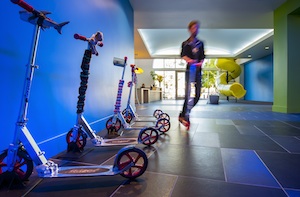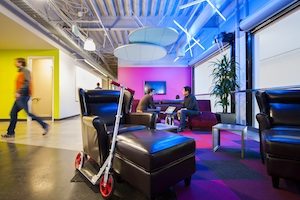22 May
Box’s Shiny New Digs
Cloud-computing firm builds itself a better box
THIS ARTICLE WAS PUBLISHED IN THE ‘Q’ – THE REGISTRY’S PRINT PUBLICATION – IN APRIL 2012
| By Janis Mara |
Now that’s a big box.
At the beginning of March, Silicon Valley cloud-computing company Box moved into its new 97,000-square-foot building. A swiftly rising entry in the online information storage and sharing field, Box had 400 employees on staff and plans to hire another 300 by 2015, enough people to fill the space.
The Los Altos building was vacated in 2010 by technology-licensing firm Rambus Inc., and the interior needed a thorough overhaul to meet Box’s workspace goals. The six-year-old company seeks to attract a young-geek demographic. Once it has workers onboard, it strives to keep them engaged, to preserve the start-up spirit of the company’s Palo Alto space and to help new hires assimilate the culture.
 The company does boast industry veterans, some of whom, like Jen Grant, the vice president of marketing, have been on staff from the beginning. Last year, Whitney Tidmarsh Bouck joined as enterprise general manager, jumping from EMC Corp.; Jon Herstein started as vice president of customer success, bringing years of experience from NetSuite Inc. Matt Self, previously at Cisco Systems Inc., was brought on as the new vice president of platform engineering, and Chris Yeh moved from Yahoo! Inc. to head up the Box platform team.
The company does boast industry veterans, some of whom, like Jen Grant, the vice president of marketing, have been on staff from the beginning. Last year, Whitney Tidmarsh Bouck joined as enterprise general manager, jumping from EMC Corp.; Jon Herstein started as vice president of customer success, bringing years of experience from NetSuite Inc. Matt Self, previously at Cisco Systems Inc., was brought on as the new vice president of platform engineering, and Chris Yeh moved from Yahoo! Inc. to head up the Box platform team.
Box was founded in 2005 in the University of Southern California dorm room of Chief Executive Aaron Levie with his friend Dylan Smith, who is now the company’s chief financial officer; the two were age 19 and 20, respectively. The first investment in Box was delivered to Levie’s dorm room from billionaire Mark Cuban: It was a check for $350,000.
The future has been anything but cloudy since, with the company receiving $162 million in investments to date—$129 million in 2011 alone. It claims that more than eight million individuals and 100,000 businesses, including 82 percent of the Fortune 500, use its managed-cloud services. In 2011, the company tripled its enterprise revenue and added The Procter & Gamble Co., The Dow Chemical Co. and McAfee Inc. to its roster of clients seeking to share, manage and collaborate in the cloud.
“When we first saw the place, it definitely wasn’t love at first sight.” Greg Strickland, vice president of business operations, BoxLast year, Box hired 215 employees, bringing total headcount to 340 at yearend. It plans to more than double that count this year. It favors the Peninsula because the location allows the company to pull developers from the South Bay and the city.
“When we first saw the place, it definitely wasn’t love at first sight,” said Greg Strickland, Box vice president of business operations, of the impression that he and Barbara Badal-Kershner, Box office supervisor, had upon entering 4440 El Camino Real. “We found ourselves looking at wood paneling, wall-to-wall white carpeting. There were black security walls. Everything was very closed in. It was not the feeling we wanted at all,” Badal-Kershner said.
What they wanted was a place with no walls, where team leaders sit with their teams, not in offices, where a worker can call across the room without having to shout over cubicle partitions. These open-plan arrangements are the designs of choice for geekly types these days—at least, the kinds that Box wants. “For a 25-year-old, 30-year-old information engineer, coder-type person, which is their target demographic, the idea is from the moment you get here you are part of something that’s pretty cool, and you are on fire from the energy and the people who are there,” said J. Edgar “Ned” Fennie Jr. of Fennie+Mehl Architects in San Francisco.
After buckling down with landlord Raj Jarkinishi, Fennie and building contractor Arne Ericson of Novo Construction, the Box team met it goals in a mere eight months, despite their initial misgivings. “That proves we still have that nimble, startup mojo,” Strickland said.
 “Initially, the place looked like a law firm, stuffy, conservative,” Fennie said—exactly the kind of place a self-respecting techie wouldn’t be caught dead in. “They want people to feel totally engaged with the project and to stay there and socialize with their coworkers in a multitude of activities, not just across the desk. They want them to flow from space to space and collaborate in any number of situations: One-to-one in a private space, in a group in a public space.”
“Initially, the place looked like a law firm, stuffy, conservative,” Fennie said—exactly the kind of place a self-respecting techie wouldn’t be caught dead in. “They want people to feel totally engaged with the project and to stay there and socialize with their coworkers in a multitude of activities, not just across the desk. They want them to flow from space to space and collaborate in any number of situations: One-to-one in a private space, in a group in a public space.”
Smaller spaces, three to five seats in a casual area, are deemed “fire pits.” “Wormholes” are places where a team can wall off the world and go deep on a particular subject. “Day camps” are slightly larger rooms for teams to brainstorm behind closed doors. Other areas are completely open, with no walls.
A proud tradition of Box is transportation via scooter. So, to connect these spaces, the architects ripped up the white carpet in the passageways, stripping the floors to the concrete so the scooters could roll unimpeded.
Another concern was helping newcomers learn the culture as the flood of new hires continues. The architects created what Fennie dubbed “landmarks.” “It’s like an historical marker on the highway,” Fennie said. “As you’re scooting by on your scooter, you see some crazy object on the wall. You can hold up your cell phone to an RFID tag next to it and get the story.”
One such story is the unicorn. As Google has its lava lamps and Yahoo! its purple and yellow, Box has its unicorn. “Dylan somewhat jokingly led a group meditation session at our office holiday party in 2009 and told us, ‘Everybody hold hands and close your eyes and think about the future and money trees and unicorns,’ and the next thing you know, unicorns appeared all over the office,” said Badal-Kershner.
“Ever since then, the unicorn has been our unofficial mascot. To Box, the unicorn symbolizes creativity and inspiration,” she said. With that in mind, the team had a gem-bedecked unicorn built by a carousel company. The playful creature now greets visitors in the lobby.
There is a game room with air hockey and Ping-Pong, as well as a cafe. To connect the first and second floors, the architect added a bright yellow slide, a tube that turns and twists and deposits passengers near the front door. Walls are splashed with hot pinks, deep blues, oranges and vivid greens. “It’s a rainbow effect, an energetic, stimulating environment where people can create,” said Badal-Kershner.
Preserving the spirit of the company’s historic space was another paramount concern. “Outside 409 Sherman [Ave.] in Palo Alto, our first building, there was a park,” said Badal-Kershner. “So when we moved to our second building, we built a park area outside. In our third building [in Los Altos], we continued the park setting by bringing the park inside.” The afternoon sun floods the park area, where comfortably padded, wide-bottomed swings and two bright orange hammocks enliven the setting.
The plants aren’t the only green feature in the building. Though the building isn’t LEED-certified, “at every juncture, we went with energy-conserving options,” Strickland said. The new building has countertops made from recycled Skyy Vodka bottles; the toilets have automatic flushing sensors, and whenever possible, recycled particleboard was used for wood structures.
While Strickland declined to comment on the renovation, at the time the work was done, it was not unusual for such jobs to come in around $50 a square foot, which at roughly 100,000 feet would suggest a cost of around $5 million.
Despite its goals of attracting young workers from the city, Box’s headquarters aren’t exactly on top of a Caltrain station—a consideration many such firms consider top priority. However, it’s about a ten-minute drive from the Caltrain station at 95 University Ave. in Palo Alto, and Box will run an employee shuttle between the two.
In the time-honored tradition of high-tech firms, Box ate its own dog food, as the expression goes, in executing its renovation plans. “We ran this project on Box,” Strickland said. The company’s managed-cloud services make it possible to store and work collaboratively on files from any location, and the team took full of advantage of this. “Computer-assisted drawings, jpeg images, schematics—the ability to put it on Box made it easy,” Strickland said. “The normal way to manage a project like this would be to have six-foot-long blueprints floating around, but here, you saw workers with iPads.”
“They were clear from the very beginning that they wanted someone to dive in and collaborate with them,” said Novo’s Ericson. “I’d work with them any day of the week; they are so appreciative. It’s hard to run into people like that these days. It was a dream team.” READ THE STORY ON THE REGISTRY
Photos courtesy of Chad Ziemendorf


